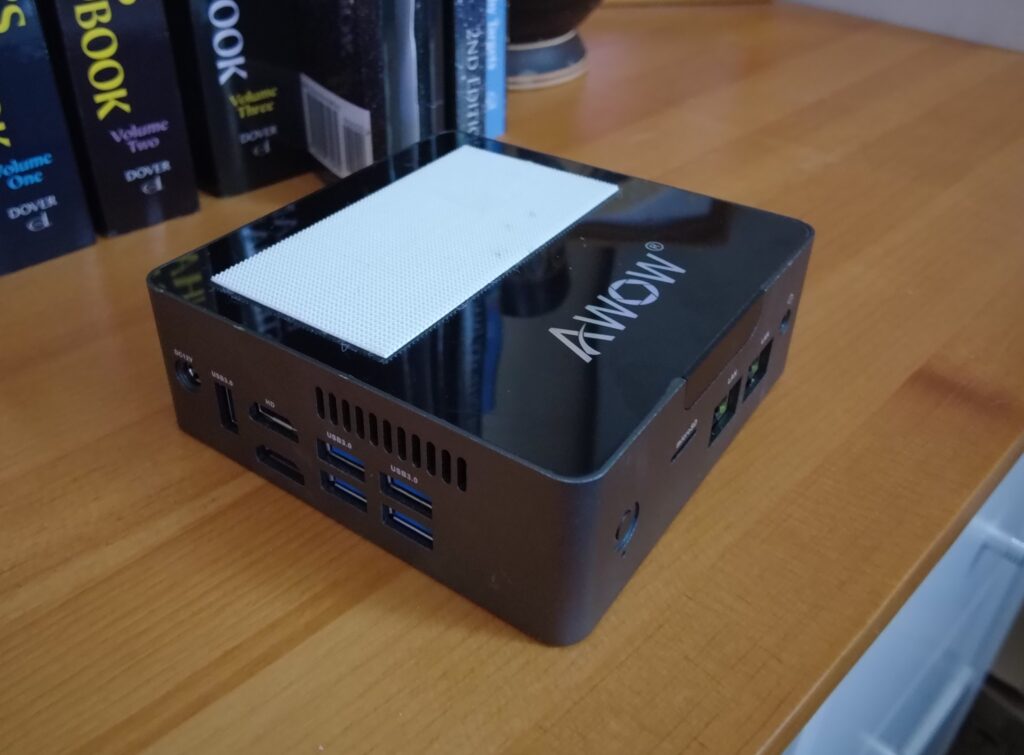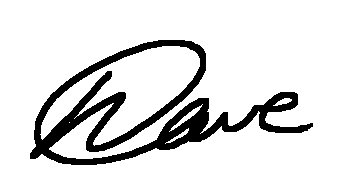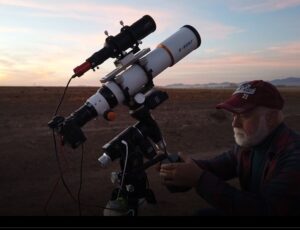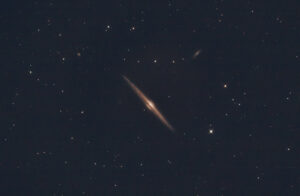There are a number of ways to manage your imaging session.
Everything from an all in one unit like ZWO’s ASIAir series of small micro pcs to laptops. Nd everything inbetween.
If you talk to a lot of astrophotographers, you will find that they use all types of ways to manage their imaging sessions.
But one of the most popular methods is to use a mini-pc on the telescope.
Most of us start out our astrophotography journey’s using our laptops. I know I did. For almost two years I had a bunch of cables coming off my rig to my laptop and battery power system.
I had a usb cable for my camera, one for my mount, one for my ZWO EAF (although I used the hub on the back of the ZWO camera to reduce the number of long usb cables I had connected to my laptop), one for my filter wheel, one for my guide camera, and the list goes on.
I had a number of usb hubs – with power – and it was a mess to setup each and every time. And I knew I wanted to move to more and more automation with my imaging sessions, the desire was to allow myself to image objects and not have to babysit my rig.
The answer I settled upon was the mini pc. My first foray into moving things from a laptop to a mini pc was an old mini pc I had purchased for a media pc in my living room. I was no longer using the device, and realized that I could perhaps use it on my telescope and have all my connections to the device and perhaps run the mini pc remotely and not have to be present at my telescope while the imaging session was underway.

And so I set it up with PHD2 and APT, my image acquisition software. I still had power cables dangling down to the battery and powerstrip I used to power the various devices, but at least once I had kicked off the imaging session, it pretty much ran without too much intervention – and my laptop was demoted – I used it to remote desktop into my mini pc on the telescope.
Nowadays, I use my mini pc as the hub for all my imaging tasks, I run all my hardware configurations and imaging session processes through my mini pc. And they have shrunk down to very small and light units and yet more powerful.
As I have moved more and more to automation, I have relied more and more on the mini pc to do the heavy lifting. As you will note below, I run a lot of software on my mini pc, and it all runs with the goal of automating as much of my imaging session as possible.
Everything from device drivers to device control panels to Stellarium, Nina and PHD2 which is heavily responsible for my being able to automate the entire process. Each piece of software performs a necessary and useful function in my goal to turn on my rig, choose my object, and run my advanced sequence and not have to worry about issues and problems that normally dog an imaging run.
To be honest and transparent, it doesn’t always run as smooth as I’d like. But I would say that it works about 80% of the time. And the times it doesn’t, it usually comes down to a software update, or it is just not a good night to image and seeing is so bad that my guiding goes to sh$t or there are high clouds and my plate solving can’t get a good enough shot to figure out where the telescope is pointing – you get the idea.
So below is the list of software, with direct links to download the software. If you have similar equipment, you too can just click on the links and download as you see fit. And of course, this is the current software as of the date of this article, it will be updated and it will change. But at least you can get these versions and then upgrade them as your needs dictate. And also note, the software listed here with the links is the latest RELEASED software. I always start out the the latest released software, and depending on my comfort level, I may decide to upgrade to a beta version, or an alpha version, or in the case of Nina, a nightly release version. Your mileage may vary depending on your risk aversion level.
Software I Install
ASCOM Platform:
https://github.com/ASCOMInitiative/ASCOMPlatform/releases/download/v6.6SP1Release/AscomPlatform661.3673.exe
Green Swamp Server for Synta mounts (Skywatcher, Orion, etc.): https://github.com/rmorgan001/GSServer/releases/download/v1.0.5.7/ASCOMGSServer1057Setup.zip
Losmandy Gemini Driver:
https://gemini-2.com/Gemini2_drivers/GeminiTelescopeInstaller(1.1.23.0).exe
Deep Sky Dad Motorized Flat Panel ASCOM Driver:
https://deepskydad.com/store/software/ASCOM%20DSD%20FP1%20Setup%20v1.0.2.exe
Deep Sky Dad Motorized Flat Panel Control Panel:
https://deepskydad.com/store/software/FP1%20Control%20Panel%20v1.0.4.zip
ZWO Camera Drivers:
https://dl.zwoastro.com/software?app=AsiCameraDriver&platform=windows86®ion=Overseas
ZWO ASCOM Drivers (install Camera drivers before installing this driver):
https://dl.zwoastro.com/software?app=ASCOMDrive&platform=windows64®ion=Overseas
ASI Studio Software (use to view fits files):
https://dl.zwoastro.com/software?app=ASIStudio&platform=windows64®ion=Overseas
Safety Monitor ASCOM Driver:
https://www.dehilster.info/docs/EnvironmentSafetyMonitorSetup.zip
Pegasus Unity Platform:
https://pegasusastro.com/release/unity/setup/PegasusAstroUnityPlatform.exe
Stellarium:
https://github.com/Stellarium/stellarium/releases/download/v23.2/stellarium-23.2-qt6-win64.exe
ASTAP:
https://sourceforge.net/projects/astap-program/files/windows_installer/astap_setup.exe/download
ASTAP D50 Star Database:
https://sourceforge.net/projects/astap-program/files/star_databases/d50_star_database.exe/download
PlateSolve3:
https://www.dropbox.com/sh/rn4uzqbs9q91q1z/AADmFhSzI_LsQUIHNCKSbm4xa?dl=1
Nina:
https://f002.backblazeb2.com/file/ninasetup/Releases/2.2.0.9001/NINASetupBundle_2.2.0.9001.zip
Nina Sky Atlas Image Repository:
https://bitbucket.org/Isbeorn/nina/downloads/SkyAtlasImageRepository.zip
Nina Offline Sky Map Cache:
https://nighttime-imaging.eu/downloads/Setup/Releases/FramingAssistantCache.zip
PHD2:
https://openphdguiding.org/phd2-2.6.11-installer.exe
PHD2 Log Viewer:
https://adgsoftware.com/phd2utils/phdlogview_setup-0.6.4.exe
Clear skies and happy guiding!



